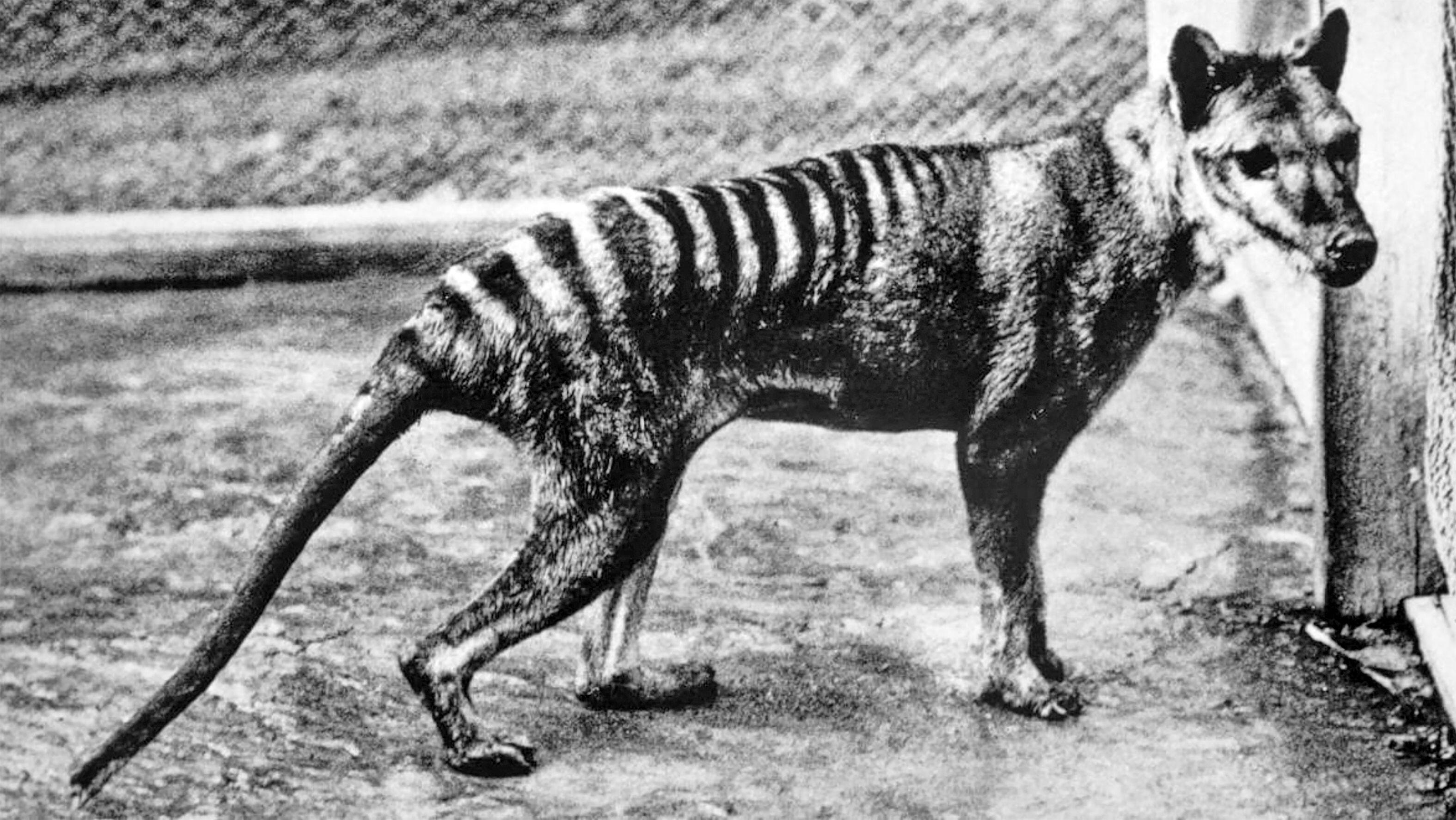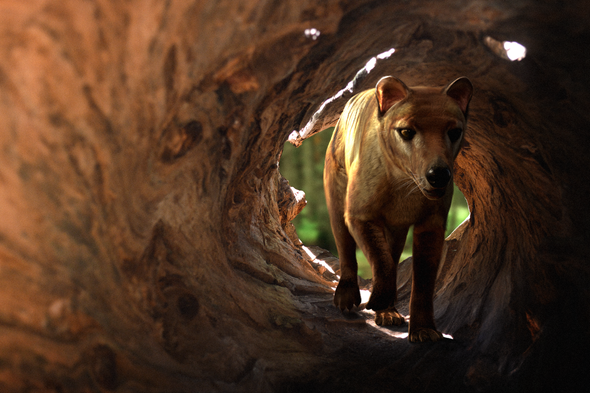The thylacine has long been an icon of human-caused extinction. In the 1800s and early 1900s, European colonizers in Tasmania wrongly blamed the dog-sized, tiger-striped, carnivorous marsupial for killing their sheep and chickens. The settlers slaughtered thylacines by the thousands, exchanging the animals’ skins for a government bounty. The last known thylacine spent its days pacing a zoo cage in Hobart, Tasmania, and died of neglect in 1936.
Now the wolflike creature—also known as the Tasmanian tiger—is poised to become an emblem of de-extinction, an initiative that seeks to create new versions of lost species. Colossal Biosciences, a Texas-based de-extinction company that made headlines last September when it revealed that it planned to bring back the woolly mammoth, announced today that its second project will be resurrecting the thylacine.
StuartHumphreys.jpg)
Australian scientists have been hoping since 1999 to use emerging genetic technologies to try to bring the thylacine back from the dead. When the species went extinct, Tasmania lost its top predator. In theory, reintroducing proxy thylacines could help restore balance to Tasmania’s remaining forests by picking off sick or weak animals and controlling overabundant herbivores such as wallabies and kangaroos, some researchers say. But early attempts at cloning the animal from museum specimens’ DNA failed, and the effort has not attracted significant funding—until this year.
Colossal Biosciences, co-founded by Harvard University geneticist George Church and tech entrepreneur Ben Lamm, is working with the University of Melbourne’s Andrew Pask, who has already sequenced most of the thylacine genome. The thylacine is the perfect candidate for de-extinction, Pask says, because it died out relatively recently, good-quality DNA is available, and its prey and parts of its natural habitat still exist.
In March his team established the Thylacine Integrated Genetic Restoration Research Lab with a philanthropic gift of five million Australian dollars (about $3.6 million). Colossal is providing “more than that” sum, Pask says—he won’t divulge exactly how much—as well as access to equipment, another dedicated thylacine lab in Texas and a large team of researchers.
With this partnership established, Pask now says it’s reasonable to expect to have “a de-extincted thylacine-ish thing” in a decade. That first iteration might be “90 percent thylacine,” he says, though the ultimate goal is more like 99.9 percent. Eventually—after many years of monitoring the engineered animals in a large enclosed area—Colossal’s goal is to release a viable, genetically-diverse population of perhaps 100 proxy thylacines into the wild.
To resurrect the woolly mammoth, Colossal’s researchers plan to introduce mammoth genes into the genome of the Asian elephant, its closest living relative. They will then try to create an embryo carrying that modified DNA that could gestate in an African elephant “surrogate” or an artificial uterus. The resulting creature would not be a mammoth per se but rather a cold-adapted “Artic elephant” with small ears, shaggy hair, a domed forehead and curved tusks, Lamm says. Yet if he showed the creature to his grandmother, she’d say “that’s a woolly mammoth,” he adds.
Already, Lamm says, Colossal has fully sequenced the Asian and African elephant genomes, collected more than fifty mammoth genomes, and begun making edits to elephant cells—but he thinks the thylacine could turn out to be easier to revive than the mammoth because of the gestation times involved. Both projects still face many hurdles, however.
For the thylacine, the first task is to complete the sequencing of the animal’s genome. Pask’s lab has about 96 percent of it down, but the final 4 percent is the trickiest, he says. “It’s like doing one of those horrible puzzles that’s all baked beans or all blue sky. Every bit looks the same, and we’re trying to figure out how it goes together.”

Next the researchers will compare the genome of the thylacine to that of one of its closest living relatives: the fat-tailed dunnart, a mouse-sized marsupial that is relatively abundant and copes well in captivity. Using CRISPR gene-editing technology, the scientists will engineer the dunnart’s genome to more closely resemble the thylacine’s.
The researchers have already figured out how to re-program dunnart skin cells into stem calls, and are currently testing them to see whether they’re capable of generating an entire embryo—something that hasn’t yet been done in marsupials, which develop differently from placental mammals such as humans and mice. Once they’ve fine-tuned the recipe, they’ll be able to use the stem cells to create a gene-edited living embryo they can insert into either a dunnart mother or an artificial marsupial womb, which they would have to invent.
Thylacine pregnancies are estimated to last just a few weeks, compared with 22 months for mammoths. And like other newborn marsupials, the baby thylacines would be little larger than a grain of rice, so even a diminutive dunnart mother could nourish them in her pouch at first. But Lamm says Colossal will work on developing a synthetic pouch, as well as a marsupial milk formula appropriate for each stage of development.
Collectively, these new marsupial reproductive technologies could become crucial tools for the conservation of extant species such as koalas or numbats, Pask says. “There is absolutely no way I would have the millions that I have now for marsupial conservation if I [wasn’t] trying to bring the Tasmanian tiger back,” he says.
Other scientists are considerably less optimistic about the project. Mammal expert Kris Helgen of the Australian Museum, who worked on sequencing the thylacine’s mitochondrial genome in 2009, thinks altering the dunnart’s DNA to truly resemble a thylacine’s will be an impossible feat. The two species are separated by as much as 40 million years of evolution, he says. Thylacines are so unlike other animals that they’re in their own taxonomic family, just as dogs are in one family of mammals and cats—from tigers to tabbies—are in another. Turning a dunnart into a thylacine, Helgen says, would be the equivalent of editing a dog’s genome until the resulting animal looked like a cat. (Mammoths and elephants are far more closely related.)
Even if Colossal could overcome the technical challenges involved, the prospect of resurrecting the thylacine raises ethical concerns, according to Carol Freeman, an animal studies researcher at the University of Tasmania. “The whole discourse is about bringing this animal back, but the welfare of the individual animals isn’t really talked about,” she says. Both dunnarts and almost-thylacines would inevitably suffer in the course of these experiments, which “cannot be justified for such an uncertain result. It would be many years, if ever, that cloned thylacines could have anything like the life they may have had—and deserve—in the wild.”
If the scientists do get to the point where they have actual living thylacines in hand, Pask says they would consult the public, including Indigenous communities, about any release. But Bradley Moggridge, a Kamilaroi environmental scientist at the University of Canberra in Australia, says Indigenous Australians should be involved now—especially Tasmanian Aboriginal peoples, who were themselves hunted by white settlers in the 19th century. “They may have ideas; they might need to get [their traditional lands] ready for this species. That could take a long time,” he says. Discussions between the Colossal team and Indigenous Australians could be beneficial for everyone, Moggridge says. Aboriginal ecological knowledge about the thylacine would have been encoded in stories and songs, and de-extinction could reignite some of them, but the researchers “need to start those conversations now.”
Other critics worry the glamour of de-extinction will rob attention and funding from conservation projects. One study in 2017 found that allocating sums to existing endangered species programs rather than giving the same amount of money to de-extinction efforts would see about two to eight times as many species saved. “It’s better to spend the money on the living than the dead,” lead author Joseph Bennett of Carleton University in Ontario told Science.
The idea that science could restore the thylacine “is just so lovely; it captures the imagination,” says Helgen, who once made a pilgrimage to visit every museum specimen of the animal in existence. “But the thylacine is extinct in Australia and in Tasmania, and there’s no way to bring it back.” Some species are simply gone forever because of how unique they were, and the thylacine is one of them, he says. “A few million dollars [are] not going to give us an escape hatch from extinction.”

